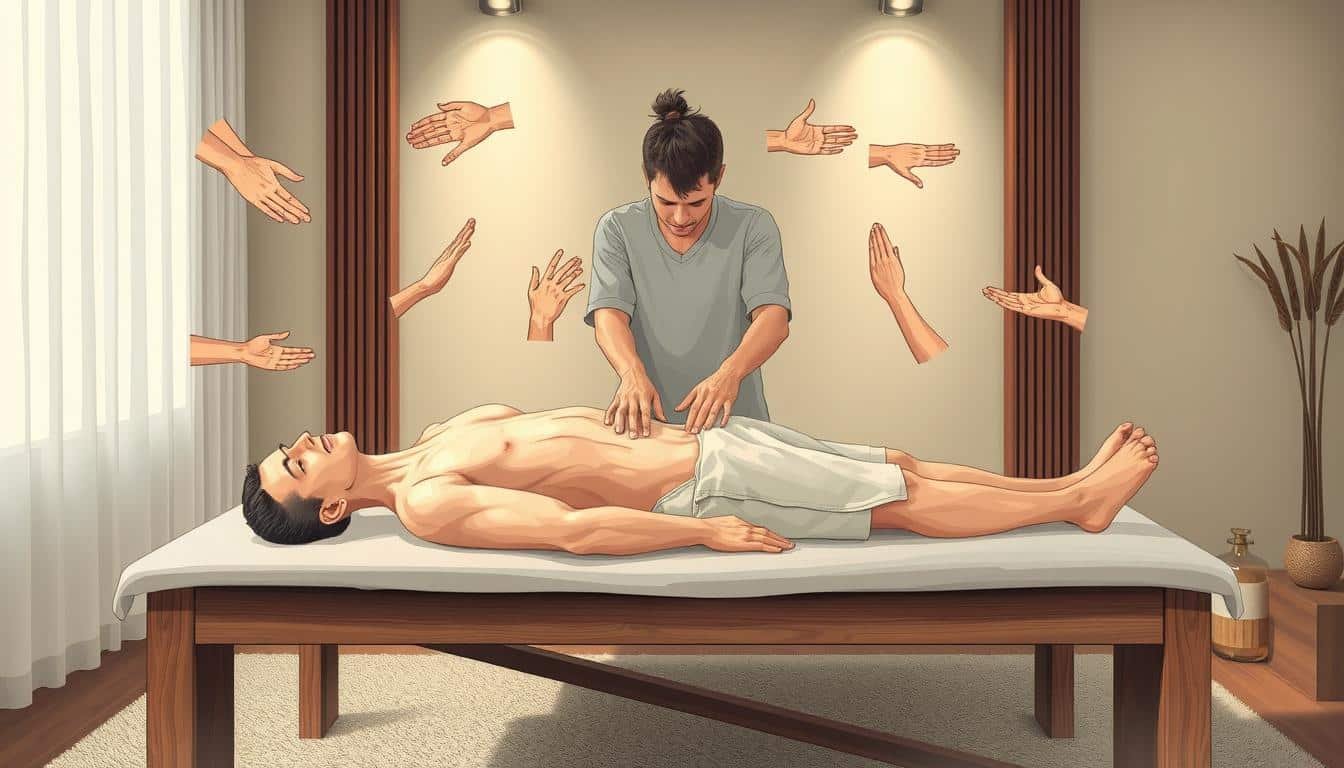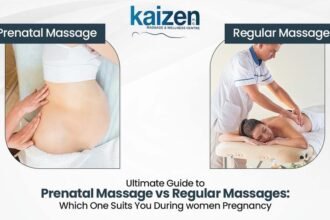Ever wondered why some massages feel amazing while others don’t? The answer might be deep tissue massage. As a massage therapist, I’ve seen how it can change tight muscles and ease pain. Here, I’ll teach you how to do a deep tissue massage well, helping you tackle tough muscle knots.
Deep tissue massage is more than just pushing hard. It’s an art that needs to know the body’s layout and how to target tight muscles. Learning these skills lets you fix issues that regular massages can’t, offering deep relief.
Key Takeaways
- Deep tissue massage targets deeper muscle layers for effective relief
- Proper technique is crucial for addressing chronic pain and tension
- Understanding anatomy enhances the effectiveness of deep tissue work
- Precise pressure application is key to massaging tight muscles
- Deep tissue massage offers benefits beyond surface-level relaxation
Understanding Deep Tissue Massage
Deep tissue massage targets the deeper layers of muscle and connective tissue. It’s great for chronic pain and improving mobility. This method uses slow, firm strokes to tackle specific tension areas in the body.
Definition and Purpose
The main goal of deep tissue massage is to break down adhesions and scar tissue. It’s especially good for muscle knots, or trigger points. Unlike trigger point therapy, which focuses on specific points, deep tissue massage works on larger areas of muscle tension.
Historical Overview
Deep tissue massage has ancient roots. The Egyptians and Romans used similar techniques thousands of years ago. It evolved over time, blending elements from various cultures. Today, it’s a recognized form of bodywork, often paired with sports massage and myofascial release.
Comparison with Other Techniques
Deep tissue massage has its own unique qualities:
| Technique | Focus | Pressure | Benefits |
|---|---|---|---|
| Deep Tissue Massage | Deeper muscle layers | Firm, intense | Pain relief, improved mobility |
| Swedish Massage | Overall relaxation | Light to moderate | Stress reduction, improved circulation |
| Sports Massage | Athletic performance | Varied | Faster recovery, injury prevention |
| Myofascial Release | Fascia (connective tissue) | Gentle, sustained | Improved flexibility, reduced pain |
Knowing these differences helps pick the right massage technique for your needs.
Benefits of Deep Tissue Massage

Deep tissue massage offers many benefits for both body and mind. It’s a powerful technique that can help with physical issues and improve overall health. Let’s look at the advantages of this effective massage method.
Physical Benefits
Deep tissue massage is great for chronic pain relief. It targets deep muscle and tissue layers, easing tension and improving movement. It’s especially good for sports injuries and speeding up recovery.
- Reduces chronic pain
- Improves posture
- Increases flexibility
- Accelerates injury healing
Mental and Emotional Benefits
Deep tissue massage does more than just relieve physical pain. It also has mental and emotional benefits. It can lower stress, promote relaxation, and improve sleep. Many people feel calm and refreshed after a session.
Improved Organ Function
Deep tissue massage can even help internal organs. Studies show it can improve heart and lung function. Some benefits include:
- Reduced blood pressure
- Lower heart rate
- Enhanced lung capacity
These benefits are especially good for people with conditions like COPD. Adding deep tissue massage to your routine can lead to better health, beyond just muscle relief.
Fundamental Techniques in Deep Tissue Massage
Deep tissue massage uses several key techniques to target tight muscles and connective tissues. Let’s dive into these methods to understand how they work.
Myofascial release is a primary technique. It focuses on the fascia, the tissue around muscles. By applying sustained pressure, it helps release tension and improve flexibility.
Trigger point therapy is another important method. I find specific points in muscles that cause pain and apply pressure to release them. This technique is great for chronic muscle tension.
When working with tight muscles, I use deep finger pressure and slow strokes. This method allows me to reach deeper muscle layers. It promotes relaxation and improves blood flow.
Cross-fiber friction is a technique I use to reduce adhesions. It involves applying pressure across muscle fibers. This can help break down scar tissue and improve mobility.
| Technique | Target | Benefit |
|---|---|---|
| Myofascial Release | Fascia | Improved flexibility |
| Trigger Point Therapy | Pain points | Reduced chronic tension |
| Deep Pressure | Deep muscle layers | Enhanced relaxation |
| Cross-fiber Friction | Adhesions | Increased mobility |
For larger muscle groups, I might use my knuckles, elbows, or forearms to apply pressure effectively. This variety in tools lets me adapt to different body areas and muscle depths.
How to Do a Deep Tissue Massage

Learning deep tissue massage techniques needs preparation, clear talk, and precise steps. I’ll show you how to do a deep tissue massage well. This way, both you and your client will enjoy the session.
Preparation and Client Communication
Make sure your client is comfy and has enough water before starting. Talk about their pain spots and what feels okay. This talk helps make the massage just right for them.
Step-by-Step Technique Guide
Here’s how to do a deep tissue massage:
- Start with soft strokes to get the muscles ready
- Slowly add more pressure, focusing on tight spots
- Use slow, firm strokes to reach deep muscle layers
- Hold steady pressure on tight areas
- Use knuckles, elbows, or forearms for extra pressure
Pressure Application and Manipulation
Getting the right pressure is key in deep tissue massage. Start soft and get firmer as the muscles warm up. Listen to your client and adjust as needed.
| Technique | Description | Best for |
|---|---|---|
| Stripping | Long, slow strokes along muscle fibers | Large muscle groups |
| Friction | Circular motions across muscle fibers | Knots and adhesions |
| Compression | Steady pressure on specific points | Trigger points |
Learning deep tissue massage takes time. Always put your client’s comfort and safety first during the session.
Target Areas for Deep Tissue Massage

Deep tissue massage targets specific body areas that often feel tight and sore. By focusing on these spots, it can offer a lot of relief and boost overall health.
The lower back is a key area for deep tissue massage. Many people hold stress here, causing long-term pain and stiffness. Using firm pressure and slow strokes, I help release this tension and improve movement.
Shoulders and neck are also common trouble spots. These muscles get tight from bad posture or too much time at a desk. With trigger point therapy, I can find and treat specific knots, giving much-needed relief.
For those who are active, sports massage in the legs is especially helpful. It helps prevent injuries and boosts performance by improving blood flow and flexibility.
| Target Area | Common Issues | Massage Technique |
|---|---|---|
| Lower Back | Chronic pain, stiffness | Firm pressure, slow strokes |
| Shoulders & Neck | Tension, knots | Trigger point therapy |
| Legs | Muscle tightness, reduced flexibility | Sports massage |
I also focus on muscles between vertebrae and behind the shoulder blades. These areas often hold a lot of tension. By working on these deeper layers, I offer deep relief and help people relax for a long time.
Tools and Equipment for Effective Deep Tissue Massage
Having the right tools is key for a great deep tissue massage. Let’s look at the essentials that make your massage better.
Essential Massage Tools
For a top-notch deep tissue massage, I use several important tools:
- Massage tables: Sturdy and adjustable for optimal client positioning
- Bolsters: Provide support and comfort during the massage
- Massage stones: Enhance pressure application in deep tissue work
- Foam rollers: Aid in myofascial release techniques
Recommended Massage Oils and Creams
Choosing the right lubricant is crucial for smooth strokes. I prefer:
| Oil/Cream | Benefits | Best For |
|---|---|---|
| Grapeseed Oil | Light, non-greasy | Sensitive skin |
| Coconut Oil | Moisturizing, antimicrobial | Dry skin |
| Arnica Cream | Anti-inflammatory | Sore muscles |
Proper Table Setup
A well-set massage table is essential for comfort and efficiency. I adjust the table height to my hip level for better leverage. Proper face cradle alignment and bolsters support the client’s body, allowing for deeper muscle penetration.
Precautions and Contraindications
Deep tissue massage has many benefits, but it’s not for everyone. As a massage therapist, I always put client safety first. Before starting a massage, I do a detailed health check.
Some conditions need extra care or might mean you can’t get deep tissue massage. These include:
- Recent injuries or surgeries
- Blood clots
- Osteoporosis
- Pregnancy
- Use of blood thinners
If you have any of these, talk to your doctor first. Pregnant women, I suggest prenatal massage instead.
| Condition | Recommendation |
|---|---|
| Recent injury | Wait for healing, consult doctor |
| Blood clots | Avoid deep tissue massage |
| Osteoporosis | Seek medical clearance first |
| Pregnancy | Choose prenatal massage |
| Blood thinners | Consult doctor, may need lighter pressure |
In my practice, I always choose caution. If a client’s health is unsure, I tell them to get medical advice before massage. This way, every massage session is safe and effective.
Aftercare and Post-Massage Recommendations
Proper aftercare is crucial after a massage. I’ll show you how to get the most out of your treatment. Follow these steps to recover well and keep the benefits going.
Hydration and Rest
Drinking water is essential after a massage. It helps remove toxins and keeps you hydrated. Resting for the day helps your body recover and enjoy the massage’s benefits.
Follow-up Exercises
Gentle stretching is good after a massage. It keeps muscles loose and prevents stiffness. Here are some easy exercises to try:
- Neck rolls
- Shoulder shrugs
- Gentle twists
- Hamstring stretches
Frequency of Sessions
The right massage frequency depends on your needs. For chronic issues, weekly massages might be needed. For wellness, monthly sessions are often enough. I customize plans for each client’s needs and how they respond to massage.
“Regular massage sessions can lead to cumulative benefits, improving overall well-being and reducing chronic pain over time.”
Follow these aftercare tips to make your massage more effective. Consistency in aftercare and regular sessions is key to enjoying massage therapy’s full benefits.
Conclusion
Deep tissue massage is a powerful tool for healing. It can change your health and well-being. I’ve shown how to do a deep tissue massage, focusing on its special techniques and benefits.
This massage method goes deeper than just relaxing the surface. It targets deeper muscle layers to ease chronic pain and tension.
In this guide, I’ve shared important deep tissue massage techniques. These skills are key for both those who practice it and those who want to learn more. The aim is to solve deep issues, not just offer quick fixes.
I suggest adding deep tissue massage to your wellness routine. It can help with pain, improve movement, and reduce stress. Before starting, talk to a qualified professional to see if it’s good for you.
With the right approach, deep tissue massage can be a big change for your health journey.
FAQ
What is deep tissue massage?
What are the key techniques used in deep tissue massage?
How does deep tissue massage differ from Swedish massage?
What are the physical benefits of deep tissue massage?
What are the mental and emotional benefits of deep tissue massage?
How should I prepare for a deep tissue massage session?
What are some common target areas for deep tissue massage?
Are there any contraindications for deep tissue massage?
How should I care for myself after a deep tissue massage session?
Source Links
- Deep tissue massage 101: A Comprehensive guide – https://spaworldhouston.com/deep-tissue-massage-101/
- A Beginner’s Guide to Deep Tissue Massage | NCC – https://www.northwestcareercollege.edu/blog/a-beginners-guide-to-deep-tissue-massage/
- An In-Depth Guide to Deep Tissue Massage – https://www.massagemag.com/guide-to-deep-tissue-massage-89900/













7 Comments
Historical overview was fascinating, but isnt it time to discuss how deep tissue massage affects athletes specifically?
Interesting read! But do we have any solid scientific evidence that deep tissue massage really works? Just curious!
Historical Overview was great, but couldnt we delve more into the scientific side of deep tissue massage effectiveness?
Does anyone else think that the historical context of deep tissue massage was glossed over? Couldve used more depth there!
Interesting read! But did anyone else wonder why the historical overview was necessary for deep tissue massage techniques?
Interesting read, but could the author elaborate more on the historical overview? It seems somewhat glossed over.